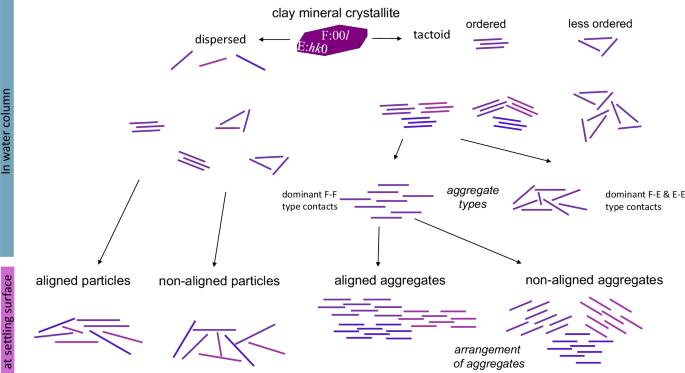Clay alignment takes place during early stages of sedimentation
IF 8.1
1区 地球科学
Q1 ENVIRONMENTAL SCIENCES
引用次数: 0
Abstract
The alignment of clay minerals in sediments is of high importance for their mechanical and physical properties. The development of this alignment starts with the deposition of clay, its strength is measured by the crystallographic preferred orientation. So far, the early stages of sedimentation have been restricted to post-mortem observations. Here we present particle settling experiments in four dimensions (time and orientation, as a function of overburden and composition) observed in situ using synchrotron diffraction, in which kaolinite and kaolinite-illite mixtures were sedimented in water columns. The alignment strength in freshly settled sediments increases with overburden, but is higher in deionized water than in seawater. Alignment strength increases within the first few millimetres of overburden and stagnates afterwards. With illite added, the resulting alignment strength is substantially decreased. Our results demonstrate that electrostatic interactions between particles are overcome by gravitational forces already within the upper millimetres of sediment. Clay minerals align in a preferred orientation already during the first stages of sediment settling, prior to deeper sediment compaction, according to particle settling experiments using 4D synchrotron diffraction and crystal-preferred orientation analysis

粘土排列发生在沉积的早期阶段
沉积物中粘土矿物的排列对其机械和物理特性非常重要。这种排列的发展始于粘土的沉积,其强度是通过晶体学的优先取向来衡量的。迄今为止,沉积的早期阶段仅限于死后观察。在这里,我们介绍了利用同步辐射衍射技术现场观测到的四维(时间和取向,作为覆盖层和成分的函数)颗粒沉降实验,其中高岭石和高岭石-illite 混合物在水柱中沉降。新沉淀物中的排列强度随覆盖层的增加而增加,但在去离子水中的排列强度高于海水中的排列强度。排列强度在覆土的最初几毫米内增加,之后则停滞不前。加入伊利石后,排列强度大幅降低。我们的研究结果表明,在沉积物上部几毫米的范围内,颗粒之间的静电相互作用已经被重力所克服。根据使用四维同步辐射衍射和晶体优选取向分析法进行的颗粒沉降实验,粘土矿物在沉积物沉降的第一阶段,即沉积物深层压实之前,就已按优选取向排列。
本文章由计算机程序翻译,如有差异,请以英文原文为准。
求助全文
约1分钟内获得全文
求助全文
来源期刊

Communications Earth & Environment
Earth and Planetary Sciences-General Earth and Planetary Sciences
CiteScore
8.60
自引率
2.50%
发文量
269
审稿时长
26 weeks
期刊介绍:
Communications Earth & Environment is an open access journal from Nature Portfolio publishing high-quality research, reviews and commentary in all areas of the Earth, environmental and planetary sciences. Research papers published by the journal represent significant advances that bring new insight to a specialized area in Earth science, planetary science or environmental science.
Communications Earth & Environment has a 2-year impact factor of 7.9 (2022 Journal Citation Reports®). Articles published in the journal in 2022 were downloaded 1,412,858 times. Median time from submission to the first editorial decision is 8 days.
 求助内容:
求助内容: 应助结果提醒方式:
应助结果提醒方式:


